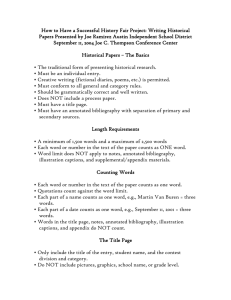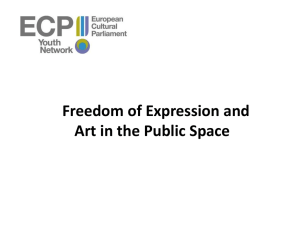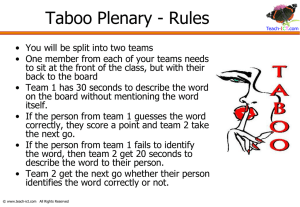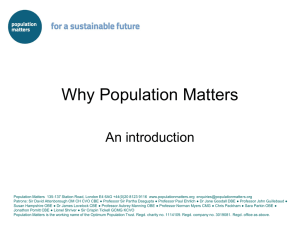The Influence of Priming on Cognitive Bias for Taboo Words Using
advertisement
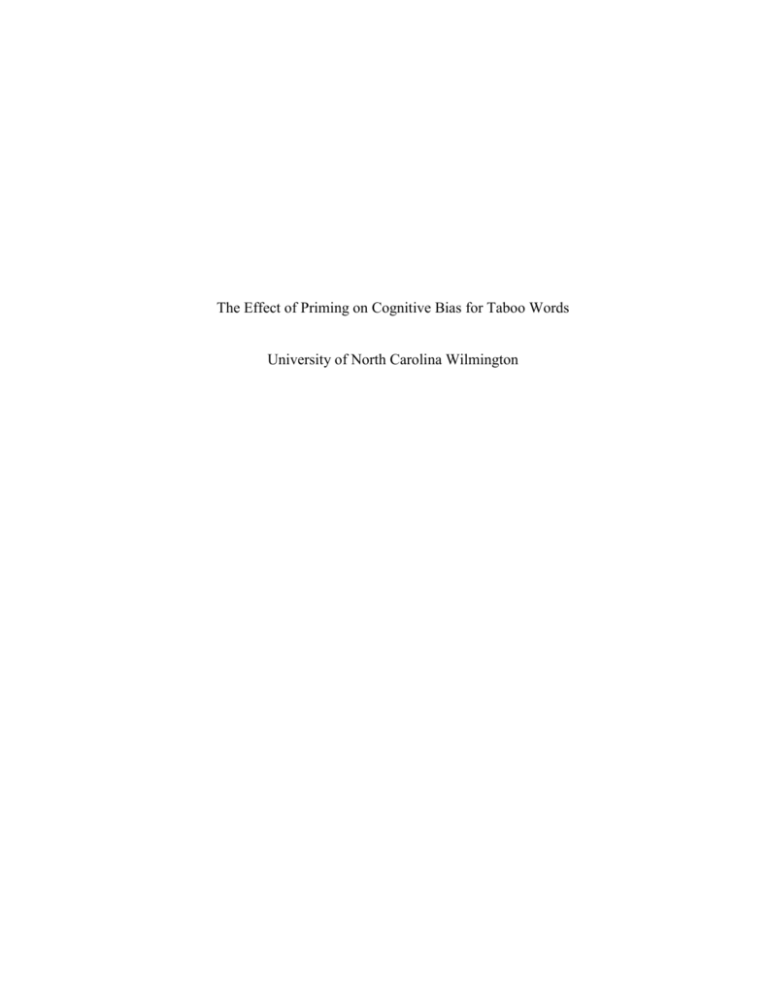
The Effect of Priming on Cognitive Bias for Taboo Words University of North Carolina Wilmington 2 Abstract Past research has shown superior recall for taboo words in experimental tasks (Hadley & MacKay, 2006; MacKay et al., 2004). The current study assessed the influence of exposure to taboo images on recall for taboo words using an incidental learning task. Twenty two participants rated forty images on emotionality based on random assignment to either a taboo priming condition, which consisted of neutral images (e.g. pen), positive emotional images (e.g. fireworks), negative emotional images (e.g. starving dog), and taboo images (e.g. blue hair), or a control priming condition which used the same format but replaced taboo images with social status images (e.g. diamond ring). Participants then rated sixty words, 30 neutral (e.g. shape), 10 positive emotional (e.g. celebrate), 10 negative emotional (e.g. betrayal), and 10 taboo (e.g. bastard), based on emotionality. An incidental learning task was administered following the word rating task. Though the direction of the effect was not predicted, it was hypothesized that taboo priming would influence recall for taboo words as compared to neutral, positive emotional, and negative emotional words. Though there was a general bias for taboo words relative to other categories, exposure to taboo images did not produce a significant effect on recall. This result could have occurred due to a number of reasons including incorrect assumptions regarding the nature of cognitive bias, ineffective priming, and the small sample size used. 3 Introduction The tendency to selectively attend to information that is motivationally or emotionally salient while ignoring other stimuli is called cognitive bias and is critical to our ability to process our environment (Hedreen & Hakan, 2006). Past research has shown that words that are more emotional in nature tend to be more salient in our memories (Hadley & MacKay, 2006; MacKay et al., 2004, Paivio & Smythe, 1971). This effect has been studied with several types of emotional stimuli including aggression, taboo, drugs, social phobia, and sex (Gayford, Hedreen, & Hakan, 2006). Past studies have shown that people recall taboo words better than neutral words in experimental tasks (Hadley & MacKay, 2006; MacKay et al., 2004). In a series of studies involving the relationship between emotion, memory and attention, MacKay et al. (2004) tested the effect of taboo words on memory. Using a taboo Stroop task, the researchers found longer color-naming times for taboo words as compared to neutral words, though this effect decreased when the words were repeated. Following the taboo Stroop task, researchers administered an incidental learning task and found better recall for taboo words. In a third task, researchers found that subjects remembered taboo words better than they remembered neutral words in a memory recognition task. In later studies, subjects were rapidly presented with word lists consisting of 72 taboo words and 216 neutral words. Subjects were shown six words at a time and asked to verbally recall the words to the best of their ability. Results showed that the taboo words impaired the subjects’ ability to recall the words presented before and after the taboo words, though taboo words did not impair lexical decision times. In two studies conducted by Hadley and MacKay (2006), researchers found superior recall for taboo words over neutral words, matched for familiarity, length, and category coherence, using rapid serial visual presentation (RSVP) experiments. 4 Gayford, Hedreen, and Hakan (2006) assessed attentional bias with neutral, positive emotional, negative emotional, and taboo words using an incidental learning task. Results showed taboo word recall to be better than the other categories. In another study by Gayford, Hedreen, and Hakan (2006), participants completed an incidental learning task with neutral, positive emotional, negative emotional, sex, taboo, and drug words. Though no difference was found between sex words, taboo words, or drug words, the results did show significant differences between all three categories as compared to neutral words upon retesting. Past research has also shown participants to have better recall for stimuli when presented with information about the nature of the stimuli in advance. This effect is referred to as a “priming effect” and can reflect a sensitivity and/or bias change in the recognition process brought about by attention (Farah, 1989). The priming effect has been shown to influence attention to stimuli in cognitive tasks (Johansson, Lundh, & Andersson, 2005; Labarge, Cash, & Brown, 1998; Farah, 1989). For example, body dissatisfaction has been associated with increased negative affect after exposure to thin female models (Heinberg & Thompson, 1995; Stice, Spangler, & Agras, 2001). Johansson, Lundh, & Andersson (2005) randomly primed both body satisfied women and body dissatisfied women with either a thin ideal condition or a neutral condition. Participants then completed an emotional Stroop task with performance-related and interpersonal-related threat words. The results of the study showed a significant interaction between body dissatisfaction and thin ideal priming on attentional bias for performance words. The greatest effect was seen in the body satisfied group, whose reaction to performance words increased after priming. Using a Stroop color-naming task, Labarge, Cash, & Brown (1998) compared the reactions of appearance-schematic and appearance-aschematic women to appearance words 5 (e.g. overweight) and nonappearance words (e.g. obnoxious) after exposure to either a neutral condition or a body emphasized size/appearance priming condition. Results showed that appearance-schematic participants primed in the body emphasized condition displayed greater Stroop interference in color-naming appearance over all other conditions. Spiering, Everaerd, & Elzinga (2002) studied the effects of sexual primes on reaction time to sexual pictures. Participants categorized sexual and neutral pictures that were primed by sexual, threatening, and neutral primes. Results showed participants recognized sexual pictures faster when primed with the sexual prime. The effect of priming has also been studied with addiction. Waters et al. (2003) used a modified emotional Stroop task to measure the disrupting effects of smoking related cues on participants’ reaction time to smoking-related words. Smokers were randomly assigned to either a high-dose nicotine patch (35 mg) or a placebo patch and completed the Stroop task on the 1st day they quit smoking. Results showed that participants who received the active nicotine patch displayed less attentional bias to the smoking-related cues, and made fewer errors on smoking-related words. The goal of the present study was to further examine the emotional effects of taboo on recall. Though explicit cognitive tasks have been previously used to measure recall of emotional stimuli in some studies, this study utilized the implicit nature of the incidental learning task. Whereas, explicit tasks may increase demand characteristics and produce socially desirable responses, implicit tasks assess automatic and nonconscious motivational tendencies and emotional states (Gayford, Hedreen, & Hakan, 2006). Though the exact definition of taboo is unclear, taboo was conceptually defined in the present study as an expression that deviates in a statistical nature in relation to deviance, social prohibition, and emotionality. Since cognitive bias is hypothesized to reflect 6 underlying motivational and affective states, a priming task was used to attempt to test this hypothesis. Furthermore, this study also examined results obtained from Gayford, Hedreen, & Hakan (2006) that emotional ratings of taboo words were not significantly different then emotional ratings of non-taboo words. It is hypothesized that exposure to taboo images will have an effect on subjects’ emotional state, relative to the control group, and influence recall for taboo words as compared to neutral, positive emotional, and negative emotional words. Though it is predicted that an effect will be present, the direction of the effect cannot be determined at this time. It is further hypothesized that taboo words will produce greater ratings on emotionality as compared to neutral, positive emotional, and negative emotional words. 7 Methods Participants Twenty eight undergraduate psychology students from the University of North Carolina Wilmington were recruited from psychology classes in the Social and Behavioral Sciences Department. Six participants were eliminated due to preexisting knowledge of the nature of the study. Participants received extra credit for their participation. Apparatus/Materials Dell computers with flat screened monitors were programmed with SuperLab Pro (Sedrus Corporation) to run the picture priming and word recall tasks. A standard keyboard and mouse was provided at each computer station. Participants were given an informed consent and provided with a pencil and a blank sheet of paper with only a heading for their codename, gender, age, and the date. The picture priming task was separated into a control priming condition and a taboo priming condition. Computers were randomly programmed with one of the priming conditions. The control priming condition consisted of forty images, 10 neutral (e.g. pen), 10 positive emotional (e.g. fireworks), 10 negative emotional (e.g. starving dog), and 10 social status (e.g. diamond ring). The taboo priming condition used the same format as the control condition, but replaced the 10 social status images with 10 taboo images (e.g. blue hair). All images were selected by panel discussions and ratings of their emotional nature. Images were also matched for size in order to prevent one image from physically standing out more than another image. Only ten taboo images were shown in the experimental priming group to disguise the topic of the study. Social status images were selected to serve as a control 8 because this category has not been shown to produce a cognitive bias in the past. All images were presented in a randomized order. Sixty words were used in the word rating task and were obtained from a word bank previously developed by Hedreen and Hakan (2006). The words selected were based on ratings of emotionality and were matched on ratings of imagery. The words consisted of 30 neutral (e.g. shape), 10 positive emotional (e.g. celebrate), 10 negative emotional (e.g. betrayal), and 10 taboo (e.g. bastard). There were no duplications of images and words. Based on criteria from Gayford, Hedreen, and Hakan (2006), only words that had singular definitions were selected from the word library in order to avoid ambiguity in the experiment. Proper nouns and compound words were also excluded to avoid increased recall due to semantic construction. Each participant received the same set of randomized words regardless of how they were primed. A mixed design was used in this study. Procedure To prevent distraction and ensure privacy, only 8 participants participated in the experiment at one time. Participants were told to sit at any open computer module with the word “welcome” on the screen, which indicated that the computer was set to perform the first task. Participants were told not to touch the computer until instructed. Participants were told that they were participating in a study involving emotional ratings of different stimuli. An experimenter read an informed consent out loud to the participants and had each participant sign two copies of the form. In the informed consents, participants were told that the study involves emotional subjects and that some people might find the material offensive and may not wish to participate. Participants were also instructed that they could end the experiment at any time, without penalty. A copy of the informed consent was given to the 9 participant with the office number of the principal investigator included and the second copy of the form was kept on record by the experimenter. Each participant was instructed to come up with a “codename” to ensure complete anonymity and honesty in answer selection. Participants were then instructed to “hit any key” which brought them to a screen with instructions for the picture priming task. Using the numeric keyboard provided, participants were instructed to rate each image on emotionality using a 7-point Likert-type scale with 1 representing very negative and 7 representing very positive. Participants were provided with a practice image to rate in order to ensure each participant understood the task. There was no time limit for rating the images, and the next image appeared as soon as the participant hit the key. Upon completion of the first task, participants were instructed to move to the adjacent computer module that was set to run the word rating task. Upon hitting “any key” participants were provided with a screen with instructions on how to perform the task. Participants received the same set of words, from the word bank previously described, regardless of how they were primed. Using the numeric keyboard provided, participants were instructed to rate each word on emotionality using a 7-point Likert-type scale with 1 representing very negative and 7 representing very positive. Participants were provided with a practice word to rate to ensure each participant understood the task. Participants had a maximum of eleven seconds to rate each word, and the next word appeared as soon as the participant hit the key. Following the word rating task, a surprise recall task was initiated by the computer screen, instructing the participants to write down every word they could recall from the word rating task using the blank paper and pencil provided. 10 At the end of the experiment, participants were debriefed and asked not to discuss the study with anyone else in order to minimize contamination. Participants were thanked for their time, and given research credit for their participation. 11 References Farah, M. J. (1989). Semantic and perceptual priming: How similar are the underlying mechanisms? Journal of Experimental Psychology: Human Perception and Performance, 15(1), 188-194. Gayford, M. C., Hedreen, S., & Hakan, R. L. (2006). Measurement of cognitive bias for motivationally relevant stimuli using an incidental learning task. Hadley, C. B., & MacKay, D. G. (2006). Does emotion help or hinder immediate memory? arousal versus priority-binding mechanisms. Journal of Experimental Psychology: Learning, Memory, and Cognition, 32(1), 79-88. Hedreen, S., & Hakan, R. (2006) Cognitive bias for sex word recall. Heinberg, L. J., & Thompson, J. K. (1995). Body image and televised images of thinness and attractiveness: A controlled laboratory investigation. Journal of Social and Clinical Psychology, 14, 325-338. Johansson, L., Lundh, L. G., & Andersson, G. (2005). Attentional bias for negative self-words in young women: The role of thin ideal priming and body shape dissatisfaction. Personality and Individual Differences, 38, 723-733. Labarge, A. S., Cash, T. F., & Brown, T. A. (1998). Use of modified stroop task to examine appearance-schematic information processing in college women. Cognitive Therapy and Research, 22(2), 179-190. MacKay, D. G., Shafto, M., Taylor, J. K., Marian, D. E., Abrams, L., & Dyer, J. R. (2004). Relations between emotion, memory, and attention: Evidence from taboo stroop, lexical decision, and immediate memory tasks. Memory and Cognition, 32(3), 474488. Paivo, A., & Smythe, P. C. (1971). Word imagery, frequence, and meaningfulness in short term memory. Psychonomic Science, 22(6), 333-335. Spiering, M., Everaerd, W., & Elzinga, B. (2002). Conscious processing of sexual information: Interference caused by sexual primes. Archives of Sexual behavior, 31(2), 159-164. Stice, E., Spangler, D., & Agras, W. S. (2001). Exposure to media-portrayed thin ideal images adversely affects vulnerable girls: A longitudinal experiment. Journal of Social and Clinical Psychology, 20, 270-288. Waters, A. J., Shiffman, S., Sayette, M. A., Paty, J. A., Gwaltney, C. J., Balabanis, M. (2003). Attentional bias predicts outcome in smoking cessation. Health Psychology, 22(4), 378-387. 12
